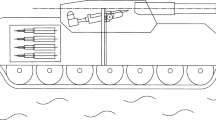Abstract
Stewart platform is a six degrees of freedom (DOF) parallel robot manipulator with rather high powerto- weight ratio and more accurate positioning that of conventional serial-link robots. Nevertheless, modelling and control of parallel Stewart platform is so abstruse and significant for vibration isolation, especially in the case with base excitation in stabilizers. In this paper a clear nonlinear dynamic model of hydraulically actuated Stewart platform with 6-DOF is presented via Kane’s method. The dynamics of Stewart platform embedded with hydraulic actuator equations is utilized to design a modern control scheme with the aim of vibration isolation. In order to attenuate upper platform vibration under uncertain base excitation profile, a novel neural network based selftuning PID (NN-PID) control scheme is implemented. Following numerical simulation results, the proposed control method satisfies vibration isolation of the upper platform under uncertain base excitation and shows well robustness against external disturbances. It is concluded that the controller is of fine adjustability and can isolate a wide range of external disturbances.
Similar content being viewed by others
References
F. Bu and B. Yao, “Nonlinear adaptive robust control of hydraulic actuators regulated by proportional directional control valves with dead band and nonlinear flow gains,” Proceedings of the American Control Conference, Chicago, pp. 4129–4133, June 2000.
J. L. Chen and W. D. Chang, “Feedback linearization control of a two-link robot using a multi-crossover genetic algorithm,” Expert Systems with Applications, vol. 36, no. 2, pp. 4154–4159, March 2009.
M. S. Cheong and D. W. Cho, “A new vibration of a hydraulic system using a heterosynaptic neural network,” Mechanical Systems and Signal Processing, vol. 11, no. 6, pp 887–901, November 1997.
Y. Jinghong, C. Zhaoneng, and L. Yuanzhang, “The variation of oil effective bulk modulus with pressure in hydraulic systems,” ASME Journal of Dynamic Systems, Measurement, and Control, vol. 116, pp. 146–150, Mrch 1994.
Y. Wu, K. Yu, J. Jiao, and R. Zhao, “Dynamic modeling and robust nonlinear control of a six-DOF active microvibration isolation manipulator with parameter uncertainties,” Mechanism and Machine Theory, vol. 92, pp. 407–435, October 2015.
B. D. Marneffe, M. Avraam, A. Deraemaeker, M. Horodinca, and A. Preumont, “Vibration isolation of precision payloads: a six-axis electromagnetic relaxation isolator,” Journal of Guidance Control and Dynamics, vol. 32, pp. 395–401, March 2009.
L. Lei and W. Benli, “Multi objective robust active vibration control for flexure jointed struts of Stewart platforms via H¥ and m synthesis,” Chinese Journal of Aeronautics, vol. 21, pp. 125–133, April 2008.
C.Wang, X. Xie, Y. Chen, and Z. Zhang, “Investigation on active vibration isolation of a Stewart platform with piezoelectric actuators,” Journal of Sound and Vibration, vol. 383, pp. 1–19, November 2016.
Z. J. Geng and L. S. Haynes, “Six degree-of-freedom active vibration control using the Stewart platforms, Control Systems Technology,” IEEE Transactions on Control Systems Technology, vol. 2, pp. 45–53, March 1994.
Z. H. Rahman, J. T. Spanos, and R. A. Laskin, “Multi axis vibration isolation, suppression, and steering system for space observational applications,” Astronomical Telescopes & Instrumentation International Society for Optics and Photonics, pp. 73–81, March 1998.
R. G. Cobb, J. M. Sullivan, A. Das, L. P. Davis, T. T. Hyde, T. Davis, Z. H. Rahman, and J. T. Spanos, “Vibration isolation and suppression system for precision payloads in space,” Smart Materials and Structures, vol. 8, p. 798, February 1999.
A. A. Hanieh A. Preumont, and N. Loix, “Piezoelectric Stewart platform for general purpose active damping,” Interface and Precision Control European Space Agency-Publications-ESASP480, pp. 331–334, September 2001.
S. Keshtkar, E. Hernandez, A. Oropez. and A. Poznyakac, “Orientation of radio-telescope secondary mirror via adaptive sliding mode control,” Neurocomputing, vol. 233, no. 12, pp. 43–51, April 2017.
B. N. Agrawal and J. Chen, “Algorithms for active vibration isolation on spacecraft using a Stewart platform,” Smart Materials and Structures, vol, 13, p. 873, June 2004.
P. Han, T. Wang, and D. Wang, “Modeling and control of a Stewart platform based six axis hybrid vibration isolation system,” Proc. of 7th World Congress on Intelligent Control and Automation, IEEE, pp. 25–27, June 2008.
Z. Wang, Y. Sun, G. Qi, and B. J. van Wyk, “Model free control based on GIMC structure,” International Journal of Control, Automation, and Systems, vol. 10, no. 1, pp. 173–179, February 2012.
G. K. I. Mann and B. W. Surgenor, “Model-free intelligent control of a 6-DOF Stewart-Gough based parallel manipulator,” Proceedings of the International Conference on Control Applications, pp. 495–500, December 2002
H. P. H. Anh, “Online tuning gain scheduling MIMO neural PID control of the 2-axes pneumatic artificial muscle (PAM) robot arm,” Expert Systems with Applications, vol. 37, pp. 6547–6560, September 2010.
A. Vasickaninova, M. Bakošova, and J. J. Kleme, “Neural network predictive control of a heat exchanger,” Applied Thermal Engineering, vol. 31, no. 13, pp. 2094–2100, September 2011.
B. Dasgupta and T. S. Mruthyunjaya, “A Newton-Euler formulation for the inverse dynamics of the Stewart platform manipulator,” Mechanism and Machine Theory, vol. 33, no. 8, pp. 1135–1152, November 1998.
H. E. Merritt, Hydraulic Control Systems, Wiley, New York, 1967.
Author information
Authors and Affiliations
Corresponding author
Additional information
Recommended by Associate Editor Kyoungchul Kong under the direction of Editor Hyun-Seok Yang.
Mostafa Taghizadeh received his Ph.D. degree in Mechanical Engineering from K.N. Toosi University of Technology, Iran in 2010. He is currently an Associate Professor of Mechanical Engineering faculty of Shahid Beheshti University, Tehran, Iran, His research interests include nonlinear control, pneumatic and hydraulic systems, and robotic.
M. Javad Yarmohammadi received his B.S. and M.S. degrees in Mechanical Engineering from Tabriz University, Iran, in 2015 and 2013, respectively. He is currently a Ph.D. student of Mechanical Engineering faculty of Shahid Beheshti University, Tehran, Iran. His research interests include nonlinear control, LPV control, wind turbine control, and robotic.
Rights and permissions
About this article
Cite this article
Taghizadeh, M., Javad Yarmohammadi, M. Development of a Self-tuning PID Controller on Hydraulically Actuated Stewart Platform Stabilizer with Base Excitation. Int. J. Control Autom. Syst. 16, 2990–2999 (2018). https://doi.org/10.1007/s12555-016-0559-8
Received:
Revised:
Accepted:
Published:
Issue Date:
DOI: https://doi.org/10.1007/s12555-016-0559-8




